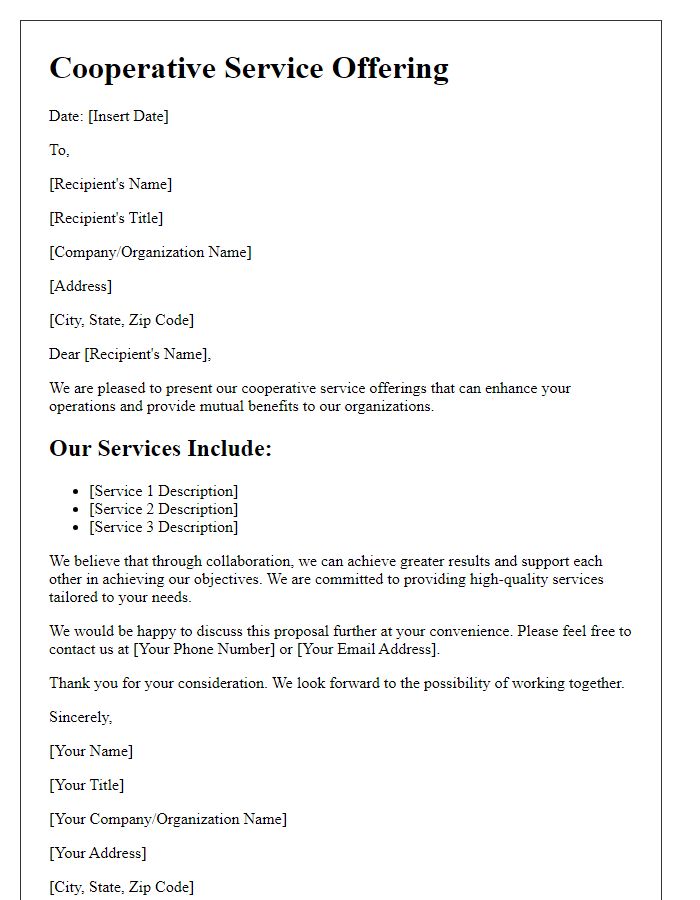Are you looking to take your business to the next level through strategic partnerships? We've crafted a letter template that makes it easy to introduce your services to potential partners in a professional yet friendly way. This template will help you highlight the mutual benefits of collaboration while clearly outlining your offerings. Ready to explore how these partnerships can enhance your success? Read on to discover our simple and effective approach!

Clear Purpose and Objectives
A strategic partnership introduction involves defining distinct objectives that align with mutual interests. Firms often seek to enhance brand visibility, increase market share, and leverage combined resources for innovative service delivery. Establishing clear communication pathways ensures each partner understands their roles and expectations. An initial meeting should outline proposed goals such as revenue growth targets, customer acquisition numbers, and collaborative marketing efforts. Metrics for success, such as performance indicators, should also be discussed to evaluate partnership effectiveness over time. Emphasizing values, shared objectives, and long-term vision fosters a conducive environment for collaboration, ultimately driving joint success in competitive markets.
Engaging Introduction
Effective partnership service introductions require clarity and enthusiasm. A well-structured presentation highlights the key benefits of collaboration. With a target audience of business leaders and decision-makers, focus on shared goals and mutual growth opportunities. Include specific data on success rates, service reach (such as market presence in over 15 countries), and case studies demonstrating past achievements. Emphasize an innovative approach, such as utilizing cutting-edge technology or unique service offerings, that distinguishes your partnership from competitors. A compelling call-to-action encourages discussion and invites potential partners to envision the future together, fostering a strong foundation for ongoing communication and collaboration.
Benefits and Value Proposition
In the evolving landscape of business collaboration, forming strategic partnerships can yield significant benefits, enhancing both service offerings and market reach. Through partnership initiatives, organizations can leverage collective strengths, streamline operational efficiencies, and access new customer segments. For instance, co-branded marketing efforts can amplify brand visibility, while shared resources may drive down operational costs, improving overall profitability. Additionally, partnerships often foster innovation, enabling firms to develop unique solutions that meet emerging market demands. Leveraging each other's networks can mutually enhance customer experiences and foster loyalty, significantly boosting competitive advantages in specific industries or geographical regions. Ultimately, the value proposition of partnership services lies in the synergistic growth potential and innovative accessibility that they present.
Call-to-Action Statement
Introducing a partnership service can significantly enhance brand visibility and collaborative opportunities. Effective communication is essential for a compelling introduction. Highlight the unique benefits of the partnership, such as improved customer engagement and access to new markets. Include a clear call-to-action (CTA) urging prospective partners to initiate discussions, schedule a meeting, or explore further details about the service offerings. Emphasize the potential for mutual growth and the innovative solutions that can emerge from the collaboration. Outline any success metrics or case studies that support the partnership's value proposition, fostering an enticing narrative for potential collaborators.
Contact Information and Follow-up Plan
Establishing a partnership service introduction requires clear and concise contact information, essential for effective communication. This includes full names, titles, and organizational affiliations of key individuals involved in the partnership. Phone numbers should be direct lines, facilitating immediate engagement. Email addresses must be professional, ideally utilizing the organization's domain. Additionally, outlining a follow-up plan is crucial for maintaining momentum in discussions. Specify timelines for follow-up communication, whether through emails or scheduled calls. Consider including regular check-in intervals, possibly bi-weekly or monthly, to ensure consistency. Ensuring both parties have agreed upon next steps promotes accountability and strengthens collaboration opportunities.













Comments